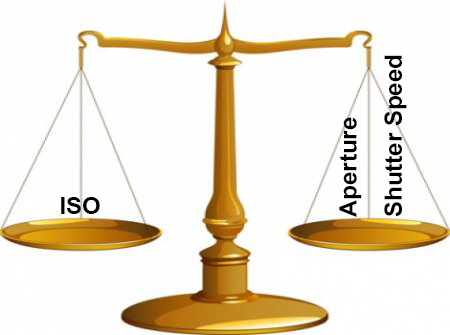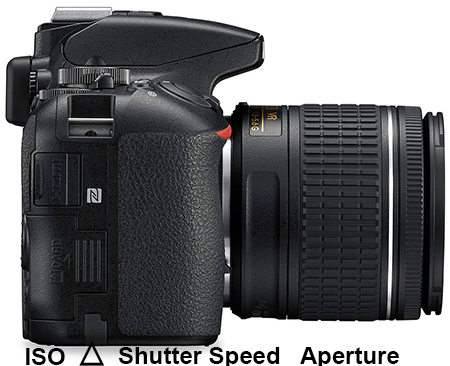Exposure and How It Works - A Beginner's Guide - Part 1
Jan 18, 2019 15:42:58 #
I’m contributing this article to explain exposure for those beginning your exploration of photography. It is key to understand some very fundamental principles in order to produce an optimum quality image. One typical reference is constantly made to a time honored device, The Exposure Triangle. That seems to introduce a bit of confusion. Let’s simplify this entire concept with something with which almost everyone has, at least, a passing acquaintance, something that is dynamic in nature. However, before we start, let’s get a couple of definitions established. So we are all discussing the same concepts across the board, let’s set a couple of descriptions for the purpose of this article. These are not my arbitrarily made up definitions. They are definitions accepted throughout the photographic world.
Exposure
In photography, it’s how much light is allowed through an opening and for how long. That’s it. And, it’s that simple.
Photographic Exposure
This involves the above definition, but includes a light sensitive material (film or sensor) upon which the light coming through a lens, or pinhole, is allowed to fall.
It is understood that the reader of this article is familiar enough with the settings of their camera where it comes to ISO, Aperture, and Shutter Speed. The idea is to balance the amount of light with a duration to effectively expose the light sensitive material optimally. That is all we are trying to accomplish.
So, with balance being brought into the discussion, let’s imagine a scale, very much like the Scales of Justice. We have a beam from which is suspended two platforms, one from either end. The idea is that the ideal exposure will occur when the balance is perfectly level. The platform on the left side will represent the camera body (where the ISO stuff happens). The platform on the right side will represent the lens aperture and shutter speed stuff.
We have a set of weights that go on the left side of the balance, and only on the left side. These weights are labeled ISO. They are in values of 50, 100, 200, 400, 800, 1600, etc. Weights for the other side of the scale are labeled f/1.4, f/2.8, f/3.5, f/4.6, f/5.6, etc. and 1, 1/2, 1/4, 1/8, etc. The weights on this side are designed to be used together in some combination.
We now have all the tools to determine a means to associate the three weights. If the beam is perfectly horizontal, we have the correct settings for an optimum exposure. For example, let’s say we have a scene that requires a setting of f/11 at 1/125 of a second to balance an ISO of 125. If we choose to change the f/11 weight to f/5.6, we are either going to have to change the 1/125 weight to another value to make the scale balance again. In this case, the 1/125 weight would have to be replaced by one of value 1/500.
There is a one to one ratio in the manner in which the right hand weights work. As we saw in the above example, we changed the f/stop weight 2 units, f/11 -> f/8 ->f/5.6, we had to change the associated weight by two units, 1/125 -> 1/250 -> 1/500, as well.
If we change the left hand side of the scale, we are going to need to change one or both of the right hand scale to keep things in balance. It’s all that simple. Once this simple concept is understood one can see that exposure becomes a system management situation. Understanding the systems completely will aid in making consistently better exposures.
--Bob
Exposure
In photography, it’s how much light is allowed through an opening and for how long. That’s it. And, it’s that simple.
Photographic Exposure
This involves the above definition, but includes a light sensitive material (film or sensor) upon which the light coming through a lens, or pinhole, is allowed to fall.
It is understood that the reader of this article is familiar enough with the settings of their camera where it comes to ISO, Aperture, and Shutter Speed. The idea is to balance the amount of light with a duration to effectively expose the light sensitive material optimally. That is all we are trying to accomplish.
So, with balance being brought into the discussion, let’s imagine a scale, very much like the Scales of Justice. We have a beam from which is suspended two platforms, one from either end. The idea is that the ideal exposure will occur when the balance is perfectly level. The platform on the left side will represent the camera body (where the ISO stuff happens). The platform on the right side will represent the lens aperture and shutter speed stuff.
We have a set of weights that go on the left side of the balance, and only on the left side. These weights are labeled ISO. They are in values of 50, 100, 200, 400, 800, 1600, etc. Weights for the other side of the scale are labeled f/1.4, f/2.8, f/3.5, f/4.6, f/5.6, etc. and 1, 1/2, 1/4, 1/8, etc. The weights on this side are designed to be used together in some combination.
We now have all the tools to determine a means to associate the three weights. If the beam is perfectly horizontal, we have the correct settings for an optimum exposure. For example, let’s say we have a scene that requires a setting of f/11 at 1/125 of a second to balance an ISO of 125. If we choose to change the f/11 weight to f/5.6, we are either going to have to change the 1/125 weight to another value to make the scale balance again. In this case, the 1/125 weight would have to be replaced by one of value 1/500.
There is a one to one ratio in the manner in which the right hand weights work. As we saw in the above example, we changed the f/stop weight 2 units, f/11 -> f/8 ->f/5.6, we had to change the associated weight by two units, 1/125 -> 1/250 -> 1/500, as well.
If we change the left hand side of the scale, we are going to need to change one or both of the right hand scale to keep things in balance. It’s all that simple. Once this simple concept is understood one can see that exposure becomes a system management situation. Understanding the systems completely will aid in making consistently better exposures.
--Bob


Jan 18, 2019 15:50:24 #
I have seen illustrations that use an equilateral triangle balance. Each of the corners accept ISO, Aperture, Shutter Speed values to level the triangle.
Jan 18, 2019 15:57:01 #
sirlensalot
Loc: Arizona
Good explanation. Have read one or two points of view that ISO has nothing to do with exposure. I guess that can be torqued as a fairly accurate statement?
Jan 18, 2019 16:02:49 #
ISO is the digital sensor equivalent of the film speed (actually light sensitivity).
sirlensalot wrote:
Good explanation. Have read one or two points of view that ISO has nothing to do with exposure. I guess that can be torqued as a fairly accurate statement?
Jan 18, 2019 16:08:24 #
Brilliant! A new way to look at the Exposure Triangle. Great contribution.
Jan 18, 2019 16:32:28 #
John_F wrote:
ISO is the digital sensor equivalent of the film speed (actually light sensitivity).
I don't think this is quite correct, but I hope others will explain why not...😕
Jan 18, 2019 16:40:36 #
Great stuff, Bob! A real throwback explained in a new way.
Actually, this is the "old" way many of us were taught in the 50s and 60s, when ISO was pretty much limited and considered a fixed quantity for most working photographers, a way of lowering the quantity you have to have on the other end of the balance.
My first photography teacher explained it that your image was a bucketful of light. Higher film speeds represented a smaller bucket, slower film speeds a larger one.
You could fill the bucket by turning the faucet on to a trickle or wide open - this is your aperture. If you turned it down to a trickle, you'd need to leave it open for a longer "shutter speed". If you opened the tap wide open, you could fill the bucket faster, hence a shorter shutter speed.
I really like Bob's analogy though - perfect for the new digital age.
Andy
Fotoartist wrote:
Brilliant! A new way to look at the Exposure Triangle. Great contribution.
Actually, this is the "old" way many of us were taught in the 50s and 60s, when ISO was pretty much limited and considered a fixed quantity for most working photographers, a way of lowering the quantity you have to have on the other end of the balance.
My first photography teacher explained it that your image was a bucketful of light. Higher film speeds represented a smaller bucket, slower film speeds a larger one.
You could fill the bucket by turning the faucet on to a trickle or wide open - this is your aperture. If you turned it down to a trickle, you'd need to leave it open for a longer "shutter speed". If you opened the tap wide open, you could fill the bucket faster, hence a shorter shutter speed.
I really like Bob's analogy though - perfect for the new digital age.
Andy
Jan 18, 2019 16:41:34 #
So have I, along with a number of other people who seem to express a lot of confusion regarding that.
--Bob
--Bob
John_F wrote:
I have seen illustrations that use an equilateral triangle balance. Each of the corners accept ISO, Aperture, Shutter Speed values to level the triangle.
Jan 18, 2019 16:42:53 #
You are correct, up to a point. That is why I included a definition of Photographic Exposure. That does take into account ISO.
--Bob
--Bob
sirlensalot wrote:
Good explanation. Have read one or two points of view that ISO has nothing to do with exposure. I guess that can be torqued as a fairly accurate statement?
Jan 18, 2019 16:43:24 #
Thank you, Fotoartist.
--Bob
--Bob
Fotoartist wrote:
Brilliant! A new way to look at the Exposure Triangle. Great contribution.
Jan 18, 2019 16:54:32 #
Jan 18, 2019 17:00:36 #
Andy, thanks for viewing and the comments. Stay tuned for parts 2 and 3. We get to play with water.
--Bob
--Bob
AndyH wrote:
Great stuff, Bob! A real throwback explained in a ... (show quote)
Jan 18, 2019 17:00:56 #
Jan 18, 2019 17:02:37 #
John, for all practical and conversational purposes, you're correct. For an electrical engineering class, there's a difference. But, we're chatting about photography here.
--Bob
--Bob
John_F wrote:
ISO is the digital sensor equivalent of the film speed (actually light sensitivity).
Jan 18, 2019 18:04:25 #
rmalarz wrote:
Only 'til selmslie shows up ... But, we're chatting about photography here. --Bob
 Sorry, couldn't resist. But you know, as well as I, that this topic will be 8 pages long by Saturday night, and it won't have anything to do with novices learning exposure.
Sorry, couldn't resist. But you know, as well as I, that this topic will be 8 pages long by Saturday night, and it won't have anything to do with novices learning exposure.
If you want to reply, then register here. Registration is free and your account is created instantly, so you can post right away.





